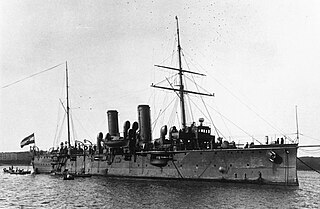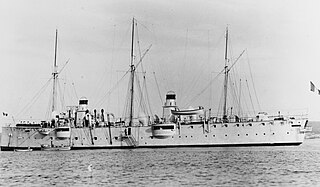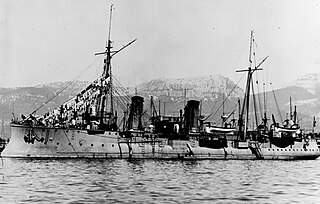
SMS Zenta was the lead ship of the Zenta class of protected cruisers built for the Austro-Hungarian Navy in the late 1890s. The class included two other vessels, Aspern and Szigetvár. The Zentas were intended to serve as fleet scouts and to guard the battleships against attacks by torpedo boats. She carried a main battery of eight 12 cm (4.7 in) guns manufactured by Škoda; Zenta and her sisters were the first major warships of the Austro-Hungarian fleet to be armed entirely with domestically produced guns. Unlike earlier Austro-Hungarian cruisers, the Zenta class discarded heavy belt armor in favor of a higher top speed.

Vérité was a pre-dreadnought battleship built for the French Navy in the mid-1900s. She was the second member of the Liberté class, which included three other vessels and was a derivative of the preceding République class, with the primary difference being the inclusion of a heavier secondary battery. Vérité carried a main battery of four 305 mm (12 in) guns, like the République, but mounted ten 194 mm (7.6 in) guns for her secondary armament in place of the 164 mm (6.5 in) guns of the earlier vessels. Like many late pre-dreadnought designs, Vérité was completed after the revolutionary British battleship HMS Dreadnought had entered service and rendered her obsolescent.

Démocratie was a pre-dreadnought battleship built for the French Navy in the mid-1900s. She was the fourth member of the Liberté class, which included three other vessels and was a derivative of the preceding République class, with the primary difference being the inclusion of a heavier secondary battery. Démocratie carried a main battery of four 305 mm (12 in) guns, like the République, but mounted ten 194 mm (7.6 in) guns for her secondary armament in place of the 164 mm (6.5 in) guns of the earlier vessels. Like many late pre-dreadnought designs, Démocratie was completed after the revolutionary British battleship HMS Dreadnought had entered service, rendering her obsolescent.

République was a pre-dreadnought battleship, the lead vessel of the République class built for the French Navy built in the early 1900s. Laid down in December 1901, she was launched in September 1902 and commissioned in January 1907. Armed with a main battery of four 305 mm (12.0 in) guns, she was outclassed before even entering service by the revolutionary British battleship HMS Dreadnought, that had been commissioned the previous December and was armed with a battery of ten guns of the same caliber. Though built to an obsolescent design, République proved to be a workhorse of the French fleet, particularly during World War I.

Patrie was the second and final member of the République class of pre-dreadnought battleships of the French Navy built between her keel laying in April 1902 and her commissioning in July 1907. Armed with a main battery of four 305 mm (12.0 in) guns, she was outclassed before even entering service by the revolutionary British battleship HMS Dreadnought, that had been commissioned the previous December and was armed with a battery of ten guns of the same caliber. Though built to an obsolescent design, Patrie proved to be a workhorse of the French fleet, particularly during World War I.

Léon Gambetta was the lead ship of her class of three armored cruisers built for the French Navy in the first decade of the 20th century. Armed with four 194-millimeter (7.6 in) guns, the ships were much larger and more powerfully armed than their predecessors. Completed in 1905, she was initially assigned to the Northern Squadron where she served as a flagship. The ship was transferred to the Mediterranean Squadron in 1910 and remained there for the rest of her career.

The Léon Gambetta class consisted of three armored cruisers built for the French Navy during the first decade of the 20th century. Armed with four 194-millimeter (7.6 in) guns, the ships were much larger and more powerfully armed than their predecessors. Léon Gambetta, the first of the sister ships to be completed, was initially assigned to the Northern Squadron where she served as a flagship. Her sisters Jules Ferry and Victor Hugo were assigned to the Mediterranean Squadron where Jules Ferry also served as a flagship. Léon Gambetta joined them there in 1910 and the sisters remained there for most of their careers.

Jules Ferry was the second of three Léon Gambetta-class armored cruisers built for the French Navy during the first decade of the 20th century. Armed with four 194-millimetre (7.6 in) guns, the ships were much larger and more powerfully armed than their predecessors. Completed in 1907, she was assigned to the Mediterranean Squadron where she served as a flagship.

Châteaurenault was a large protected cruiser built for the French Navy in the late 1890s and early 1900s. She was intended to serve as a long-range commerce raider, designed according to the theories of the Jeune École, which favored a strategy of attacking Britain's extensive merchant shipping network instead of engaging in an expensive naval arms race with the Royal Navy. As such, Châteaurenault was built with a relatively light armament of just eight medium-caliber guns, but was given a long cruising range and the appearance of a large passenger liner, which would help her to evade detection while raiding merchant shipping.

D'Estrées was the lead ship of her class of protected cruisers built for the French Navy in the late 1890s. The class was ordered as part of a construction program directed at strengthening the fleet's cruiser force at a time the country was concerned with the growing naval threat of the Italian and German fleets, and were intended to serve overseas in the French colonial empire. D'Estrées was armed with a main battery of two 138 mm (5.4 in) guns, was protected by an armor deck that was 38 to 43 mm thick, and was capable of steaming at a top speed of up to 20 to 20.5 knots.

The D'Estrées class comprised two protected cruisers of the French Navy built in the late 1890s. The two ships were D'Estrées and Infernet, though a third was projected but was canceled before work began. They were ordered during a period of intense debate in the French fleet between officers who favored large armored cruisers and those who preferred smaller vessels more suited to long-distance cruising abroad. The D'Estrées-class cruisers were intended to operate in the French colonial empire. The ships were armed with a main battery of two 138 mm (5.4 in) guns supported by four 100 mm (3.9 in) guns and they had a top speed of 20 to 20.5 knots.

The French cruiser Victor Hugo was the last of three Léon Gambetta-class armored cruisers built for the French Navy during the first decade of the 20th century. Armed with four 194-millimeter (7.6 in) guns, the ships were much larger and more powerfully-armed than their predecessors. Completed in 1907, she was assigned to the Mediterranean Squadron.

The Forbin class was a group of three protected cruisers built for the French Navy in the late 1880s and early 1890s. The class comprised Forbin, Coëtlogon, and Surcouf. They were ordered as part of a fleet program that, in accordance with the theories of the Jeune École, proposed a fleet based on cruisers and torpedo boats to defend France. The Forbin-class cruisers were intended to serve as flotilla leaders for the torpedo boats, and they were armed with a main battery of four 138 mm (5.4 in) guns.

Descartes was the lead ship of the Descartes class of protected cruisers built for the French Navy in the 1890s. The Descartes-class cruisers were ordered as part of a construction program directed at strengthening the fleet's cruiser force. At the time, France was concerned with the growing naval threat of the Italian and German fleets, and the new cruisers were intended to serve with the main fleet, and overseas in the French colonial empire. Descartes was armed with a main battery of four 164.7 mm (6.5 in) guns, was protected by an armor deck that was 20 to 40 mm thick, and was capable of steaming at a top speed of 19 knots.

Catinat was the lead ship of the Catinat class of protected cruisers built for the French Navy in the 1890s. The Catinat-class cruisers were ordered as part of a construction program directed at strengthening the fleet's cruiser force at a time the country was concerned with the growing naval threat of the Italian and German fleets. The new cruisers were intended to serve with the main fleet and overseas in the French colonial empire. Catinat was armed with a main battery of four 164 mm (6.5 in) guns, was protected by an armor deck that was 25 to 60 mm thick, and was capable of steaming at a top speed of up to 20 knots.

Protet was a protected cruiser of the French Navy built in the 1890s, the second and final member of the Catinat class. The Catinat-class cruisers were ordered as part of a construction program directed at strengthening the fleet's cruiser force at a time when the country was concerned with the growing naval threat of the Italian and German fleets. The new cruisers were intended to serve with the main fleet and overseas in the French colonial empire. Protet was armed with a main battery of four 164 mm (6.5 in) guns, was protected by an armor deck that was 25 to 60 mm thick, and was capable of steaming at a top speed of up to 20 knots.

D'Iberville was the lead ship of the D'Iberville class of torpedo cruisers built for the French Navy in the 1890s. The class is also sometimes classified as torpedo gunboats or torpedo avisos. The D'Iberville-class ships were a development of earlier torpedo cruisers, with the chief improvement being a significantly higher speed. D'Iberville was armed with six 450 mm (17.7 in) torpedo tubes and a single 100 mm (3.9 in) gun as her primary offensive armament, though she had all of her torpedo tubes removed in 1896, just two years after entering service.

Cassini was the second member of the D'Iberville class of torpedo cruisers built for the French Navy in the 1890s. The class is also sometimes classified as torpedo gunboats or torpedo avisos. The D'Iberville-class ships were a development of earlier torpedo cruisers, with the chief improvement being a significantly higher speed. Cassini was armed with three 450 mm (17.7 in) torpedo tubes and a single 100 mm (3.9 in) gun as her primary offensive armament.

Casabianca was the third and final member of the D'Iberville class of torpedo cruisers built for the French Navy in the 1890s. The class is also sometimes classified as torpedo gunboats or torpedo avisos. The D'Iberville-class ships were a development of earlier torpedo cruisers, with the chief improvement being a significantly higher speed. Casabianca was armed with three 450 mm (17.7 in) torpedo tubes and a single 100 mm (3.9 in) gun as her primary offensive armament.






















